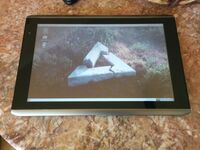Acer Iconia Tab A500 (acer-picasso)
 | |
| Manufacturer | Acer |
|---|---|
| Name | Iconia Tab A500 |
| Codename | acer-picasso |
| Released | 2011 |
| Type | tablet |
| Hardware | |
| Chipset | Nvidia Tegra 2 (T20) |
| CPU | Dual-core 1.0 GHz Cortex-A9 |
| GPU | ULP GeForce |
| Display | 1280x800 |
| Storage | 16/32 GB |
| Memory | 1 GB |
| Architecture | armv7 |
| Software | |
Original software The software and version the device was shipped with. |
Android 3.0 |
Extended version The most recent supported version from the manufacturer. |
Android 4.0 |
| postmarketOS | |
| Category | testing |
Mainline Instead of a Linux kernel fork, it is possible to run (Close to) Mainline. |
yes |
pmOS kernel The kernel version that runs on the device's port. |
5.15.0-rc4 |
Unixbench score Unixbench Whetstone/Dhrystone score. See Unixbench. |
299.5 |
| Device package |
|
| Kernel package |
|
Flashing Whether it is possible to flash the device with pmbootstrap flasher. |
Works
|
|---|---|
USB Networking After connecting the device with USB to your PC, you can connect to it via telnet (initramfs) or SSH (booted system). |
Works
|
Battery Whether charging and battery level reporting work. |
Works
|
Screen Whether the display works; ideally with sleep mode and brightness control. |
Works
|
Touchscreen |
Works
|
| Multimedia | |
3D Acceleration |
Partial
|
Audio Audio playback, microphone, headset and buttons. |
Works
|
Camera |
Broken
|
| Connectivity | |
WiFi |
Works
|
Bluetooth |
Works
|
| Miscellaneous | |
FDE Full disk encryption and unlocking with unl0kr. |
Partial
|
USB OTG USB On-The-Go or USB-C Role switching. |
Works
|
| Sensors | |
Accelerometer Handles automatic screen rotation in many interfaces. |
Works
|
Contributors
- Worldblender
Maintainer
- Worldblender
Users owning this device
- Arthurlutz (Notes: postmarketos installed)
- IonAgorria (Notes: PMOS - OK)
- PotatoProton (Notes: failing to flash u-boot)
- TwoShot (Notes: Dualbooted linux and android)
How to enter flash mode (requires a custom bootloader)
See https://forum.xda-developers.com/iconia-a500/a500-2019-2020-t4039271 for a through explanation of how to go from stock to fully modded.
To get serialnumber, use adb shell then dmesg then look for serialnumber in it.
To convert the CPUID to SDK without Windows, you can use the perl code referenced on xda-developers.
The nvflash tool is documented by Nvidia on https://http.download.nvidia.com/tegra-public-appnotes/flashing-tools.html#_nvflash
Installation
Note:If you are on the Skrilax_CZ bootloader then you have to either increase the AKB partition size to 250MB, or use the image provided by worldbender on his google drive (https://drive.google.com/drive/folders/1pMqaS5GaM6N9TAKlNGQZWCG8UTiRn4pK?usp=sharing go to kernel+firmware, download the 6.6 kernel tar file, and extract all the files inside, then after flashing the image you must add the initramfs extra into the boot partition that pmbootstrap generated)
From https://forum.xda-developers.com/iconia-a500/linux-acer-iconia-tab-a500-2020-edition-t4136023:
Follow the Installation_guide as usual, where theses specifics have to be specified when requested:
- Vendor: acer
- Device code-name: picasso
Only the mainline kernel is available for installation now, as downstream kernels no longer successfully compile. The user interface may be freely selected, as long as it is not one that requires 3D acceleration. To use KDE Plasma 5, add these lines to /etc/security/pam_env.conf:
QT_IM_MODULE=qtvirtualkeyboard
QT_QUICK_BACKEND=software
LIBGL_ALWAYS_SOFTWARE=1
From here on out, the generated chroot can be either installed to the eMMC, or a microSD card that must be inserted at or before boot time (the latter method allows for dual-booting Android already installed to the eMMC, although it can be directly accessed from the Linux system). The boot partition always has to be flashed to the eMMC in fastboot mode, as it is not possible to boot directly off of a microSD card. If installing to the eMMC, run
$ pmbootstrap install
$ pmbootstrap flasher flash_kernel --partition secboot
$ pmbootstrap flasher flash_rootfs
$ pmbootstrap flasher boot # optional
If installing to a microSD card, run
$ pmbootstrap install --sdcard $DEVICEPATH # path to the device for installation
$ pmbootstrap flasher flash_kernel --partition secboot
Depending on what user interface was chosen earlier in the installation process, there may not be enough packages installed to get a fully-loaded GUI. Besides the built-in Wi-Fi, it is also possible to use a USB ethernet adapter, or connect to another computer with a micro-USB cable and get RNDIS access that enables using SSH to the tablet.
After installation to either a microSD card or the eMMC, the screen should look like: 
Graphical Interfaces
| Interface | Info | Working |
|---|---|---|
| none | Y | |
| fbkeyboard | Y | |
| GNOME 3 | ||
| i3wm | ||
| Kodi | ||
| MATE | A lot of graphical glitches. | Y |
| Phosh | ||
| Plasma-Desktop | ||
| Plasma Mobile | ||
| Shelli | Y | |
| Sway | ||
| Weston | Y | |
| Xfce4 | Shows the 3 loading dots and then shuts down. | N |
| LXQt | Y |
U-Boot
U-Boot has been successfully ported to the acer picasso, see https://docs.u-boot.org/en/latest/board/acer/picasso.html
Notes
There is a 6.6 prebuilt kernel available by worldbender but it doesnt have most of the features, and there is a 5.15 kernel which has most of the features
Device is not actively worked on, worldbender is no longer maintaining it
On the 6.6 kernel the onscreen keyboard keeps glitching and in mate the glitches can start happening outside of the onscreen keyboard
See also
- grate kernel
- pmaports!1308 Initial merge request